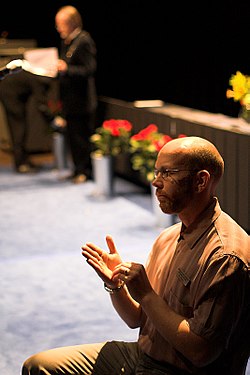Locations in American Sign Language

American Sign Language uses 12 locations excluding the hands themselves: the whole face/head; the forehead or brow; the eyes or nose; the mouth or chin; the temple, cheek or ear (side of the head); the neck; the trunk (shoulders to waist); the upper arm; the elbow or forearm, the back of the wrist, and the inside of the wrist. In addition, in asymmetric two-handed signs, the dominant hand makes contact with the non-dominant hand, which then serves as the location of the sign. A sign may also be articulated in neutral space, which is considered a default location in some models of sign language phonology. [1] [2] [3]